











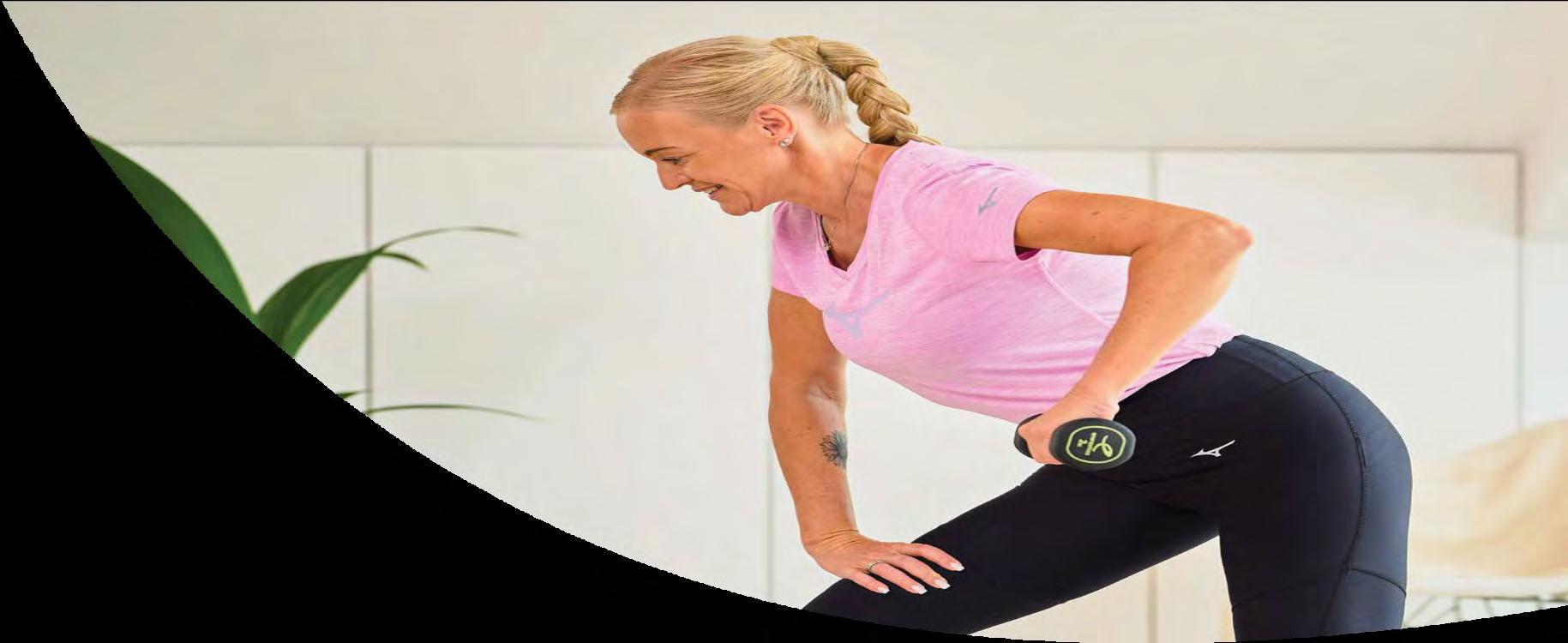














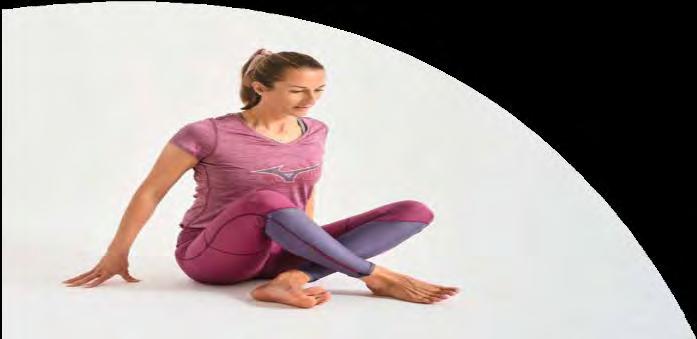


Healthy Exercise ABC Plus is amovement program that promotes an active lifestyle and aims toimprove physical and functional abilities in adults. It is an upgrade of the existing Healthy Exercise ABC program,which was the first systematic multi-month program for improving physical fitness for adults in Slovenia.The Healthy Exercise ABC Plus program includes exercises to increase strength (stability), balance, coordination, flexibility, and aerobic capacity. It adheres to recent global guidelines for planning healthy exercise.
Each exercise unit consists of apreparatory, main, and concluding part. The prepratory part includes dynamic warm-up exercises, the main part contains strength and balance exercises in maximum of six difficulty levels, and the concluding part includes static stretching exercises. The program is planned for 12 weeks, with 2-3 exercise units per week. Each difficulty level of the exercise is expected to be performed in 4-6 exercise units.

The program consists of three exercise periods (EP), named Exercise Periods A, B, and C. Each exercise period is divided into the first two exercise units and the second two units. Thus, within Exercise Period A, the first part is called A1and the second part is called A2. Similarly, Exercise Periods B (B1 and B2) and Exercise periods C (C1and C2) are represented. EP A includes content of the lowest volume and intensity of loads, which appropriately increase up to the conclusion of EPC.
Inthe introductory part of the program, exercises on a coordination ladder and dynamic exercises without equipment are presented. The main part includes pelvic floor muscle exercises, strengthening exercises for the whole body using various exercise equipment, and exercises for static and dynamic balance on hard, soft, and elevated surfaces. The concluding part involves static stretchingexercises.


Perform 10-12 repetitions of the exercise.You should feel the exercise as moderately strenuous. On the Borg scale, for example, moderate effort is rated at level 14. If you feel less effort (e.g., 10), choose a more difficult version of the exercise. Ifyou feel more effort (e.g.,16), choose an easier version of the exercise.
SCALE Rate of Perceived Exertion
VERY LIGHT ACTIVITY
Hardly any exertion, but more than sleeping, watchingTV, etc.
LIGHT ACTIVITY
Feels like you can maintain for hours, easy to breathe and carry on a conversation.
MODERATE ACTIVITY
Breathing heavily but you can still hold a short conversation. Still somewhat comfortable, but becoming noticeably more challenging.
VIGOROUS ACTIVITY
Borderline uncomfortable, short of breath, can speak asentence.
VERY HARD ACTIVITY
Very difficult to maintain exercise intensity, can barely breathe, and can speak only a few words.
MAXIMAL EFFORT
Feels almost impossible to keep going, completely out of breath, unable to talk, cannot maintain for more than a very short amount of time.

• Movement should be smooth, with each repetition of the exercise lasting approximately two seconds.
• Breathe evenly and do not hold your breath.
• Maintain an upright and tense torso and keep your head in line with your spine during exercises.
• For exercises performed standing, keep your knees slightly bent.
• Exercises performed with only one limb or to one side should be completed with all repetitions on one limb or side first, and then on the other limb or side.
• Certain exercises can also be performed in an isometric contraction mode (the exercise position is held for for at least 3 seconds). Particular care should be taken with exercisers with associated medical conditions, such as cardiovascular disease, as isometric contractions place a greater strain on the cardiovascular system than dynamic performance of the same exercise.


Aerobic and Coordination Tasks on the Ladder:
12tasks, repeat 30 seconds each task.



PREPARATORY PART - WARM-UP /Aerobic and Coordination Tasks on the Ladder


Walking backwards, both feet in each square.
Walking forward three squares, then one backwards.


Walking sideways,one foot in each square (legcrossing).
PREPARATORY PART - WARM-UP /Aerobic and Coordination Tasks on the Ladder


Walking forward, in the square and apart over the next.
Walking backwards, in the square and apart over the next.


Walking forward over the obstacles.
PREPARATORY PART - WARM-UP /Aerobic and Coordination Tasks on the Ladder


Walking sideways over the obstacles, both feet in each square.
Walking sideways over the obstacles (leg crossing).


Walking backwardsover the obstacles.
8 exercises, 10repetitions each.



1.
Swings with arms diagonally back.
Circulararm movements backwards.
Torso twistswith hands on the back of the neck.


Lifts of opposite limbs while supported with the forearm against thewall.
PREPARATORY PART - WARM-UP / Free Gymnastic Warm-Up Exercises





Turning thumbsbackwards in a half-squat with a forward bend.
Leg raiseswhile supported with the back against the wall.
the coccyx against thewall.





Lie on your back on a mat, legs bent, arms alongside your body. Contract the pelvic floor muscles. Hold the contracted muscles for 6-8 seconds, then do 3 strong squeezes. Repeat five times (there is a 5-second break between repetitions).




Lie on your stomach, one leg is bent to the side, with your forehead resting on your hands.
Contract the pelvic floor muscles.

Hold the contracted muscles for 6-8 seconds, then do 3 strong squeezes. Repeat five times (there is a 5-second break between repetitions).




Sit on a chair bent forward, resting your elbows on your thighs. Contract the pelvic floor muscles.

Hold the contracted muscles for 6-8 seconds, then do 3 strong squeezes. Repeat five times (there is a 5-second break between repetitions).




Kneel on a mat and lean on your forearms, with your forehead resting on your arms.
Contract the pelvic floor muscles.

Hold the contracted muscles for 6-8 seconds, then do 3 strong squeezes. Repeat five times (there is a 5-second break between repetitions).



1

Stand astride slightly bent forward, and your legs slightly bent. Rest your hands on your knees with your palms facinginwards.
Contract the pelvic floor muscles.

Hold the contracted muscles for 6-8 seconds, then do 3 strong squeezes. Repeat five times (there is a 5-second break between repetitions).




Stand with your knees slightly bent. With your hands on your buttocks, make sure you don’t squeeze your gluteal muscles during the exercise. Contract the pelvic floor muscles.

Hold the contracted muscles for 6-8 seconds, then do 3 strong squeezes. Repeat five times (there is a 5-second break between repetitions).





Lie on your back on a mat with your knees bent. Hold the dumbbells in your hands with your arms extended.
Raise and lower the dumbbells, stopping the motion before your arms touch the ground.

Do10-12 repetitions.
Repeat threetimes.






Sit on a chair, holding a taut resistance band in your hands. Push the resistance band forward. Do10-12 repetitions. Repeat threetimes.





Lean against awall with your hands shoulder-widthapart.
Perform push-ups.

Do 10-12 repetitions.
Repeat threetimes.





Kneel on a mat with your arms extended. The angle at the hip and knee should be greater than 90° .
Perform push-ups.

Do10-12 repetitions.
Repeat threetimes.





Place your hands on a bench,shoulder-width apart. Perform push-ups.

Do 10-12 repetitions. Repeat threetimes.






Forearm plank position on a mat with your toes on the ground.

Alternate lifting into a plank position on extended arms, first with your right arm and then with your left. Do 10-12 repetitions.
Repeat threetimes.





Sit bending forward on a chair, holding a stick behind you, touching your head, your back between the shoulder blades, and your sacrum.
Raise your torso to an upright position.

Do10-12 repetitions.
Repeat threetimes.





Sit bending forward on a chair, cross your arms holding a resistance band.

Lift your torso to an upright position. Do10-12 repetitions. Repeat threetimes.






Sit bending forward on a chair, cross your arms holding a heavier resistance band. Lift your torso to an upright position. Do 10-12 repetitions. Repeat threetimes.





Lean against awall with your sacrum, your knees slightly bent, holding a resistance band in crossed arms.

Lift your torso to an upright position. Do 10-12 repetitions.
Repeat threetimes.






Lean against awall with your forearms, with a resistance band looped around them. Simultaneously liftopposite limbs. Do 10-12 repetitions. Repeat three times with each pair of limbs.






Lean against awall with your forearms, with a heavier resistance band looped around them. Simultaneously liftopposite limbs. Do 10-12 repetitions. Repeat three times with each pair of limbs. Exercise 3 C 2





Stand with slightly bent knees against awall.Your head, shoulder blades, elbows, and sacrum are touching thewall.

Push off the wall with your elbows, allowing your head and torso to move away from thewall. Do 10-12 repetitions.
Repeat threetimes.






Seated rowswith a taut resistance band. Pull the band backward. Begin the movement by retractingyour shoulder blades, then bend your arms. Do10-12 repetitions.
Repeat threetimes.


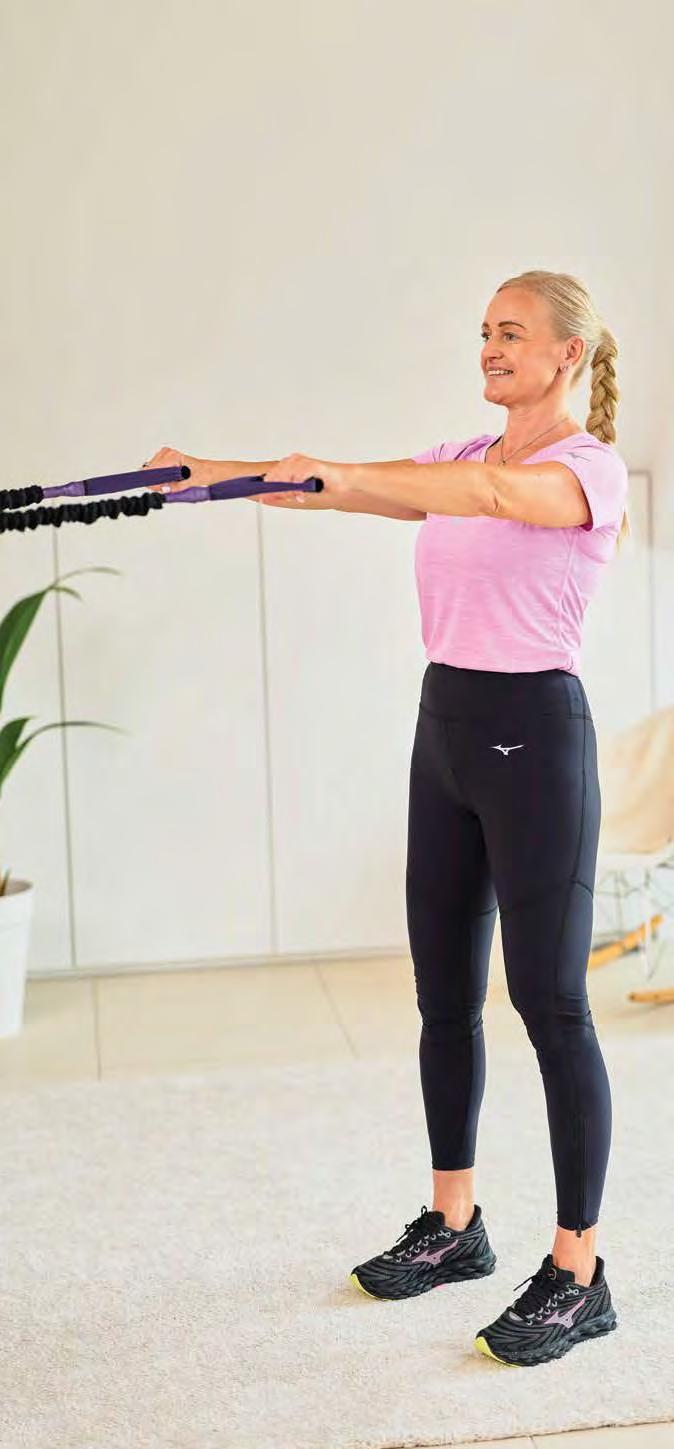



Stand with your legs apart and your knees slightly bent, holding a taut resistance band in front of you. Pull the band backward. Begin the movement by retractingyour shoulder blades, then bend your arms. Do 10-12 repetitions. Repeat threetimes.





Holding a taut rope in front of you, lean back slightly.
Pull up to a more upright position. Begin the movement by retracting your shoulder blades, then bend your arms.

Do10-12 repetitions.
Repeat threetimes.






In a bent-over half-squat position,hold the dumbbells. Lift the dumbbells. Begin the movement by retracting your shoulder blades, then bend your arms. Do 10-12 repetitions. Repeat threetimes.





In a bent-over lunge position, hold a dumbbell. Lift the dumbbell. Begin the movement by retracting your shoulder blade, then bend your arm.

Do10-12 repetitions. Repeat three times with eacharm.





Lie on your back on a mat with one leg bent, and your arms by your sides.
Lift the extended leg.

Do 10-12 repetitions.
Repeat three times with each leg.





Lie on your back on a mat with one leg bent, and your palms under the lumbar region of your trunk.
Raise the upper part of your trunk and head, supporting yourself with your elbows on the floor.

Do 10-12 repetitions.
Repeat threetimes.






Lie on your back on a mat with one leg bent, your palms under the lumbar region of your trunk, and your elbows lifted. Raise the upper part of your trunk and head. Do 10-12 repetitions.
Repeat threetimes.






Lie on your back on a mat with one leg bent. Cross your arms with your hands on your chin. Raise the upper part of your torso and head. Do10-12 repetitions. Repeat threetimes.






Lie on your back on a mat with one leg bent. Cross your arms with your hands on your forehead. Raise the upper part of your torso and head. Do10-12 repetitions.
Repeat threetimes. Exercise 5 C 1





Lie on your back on a mat with one leg bent, holding a resistance band in your hands. Raise the upper part of your torso and head.

Do10-12 repetitions.
Repeat threetimes.





Hold onto support (rope or bar) at shoulder height.
Perform squats to a 90° angle at your knees, keeping your heels on the ground.

Do10-12 repetitions.
Repeat threetimes.





Stand with your legs apart, facing awayfrom a wall, with a large ball supporting your lower back against the wall.
Hands are on your hips.
Perform squats to a 90° angle at the knees.

Do10-12 repetitions.
Repeat threetimes.





Stand in front of a chair with your arms crossed over your chest. Squat down and rock up and down on your knees.

Do10-12 repetitions.
Repeat threetimes.





Stand with your feet shoulder-width aparton a resistance band. Hold the ends of the band in your hands,which are positioned against your upper arms.
Perform squats to a 90° degree angle at the knees.

Do10-12 repetitions.
Repeat threetimes.




Exercise 6 C 1

Stand in front of a chairwith one leg in front and your knees bent, and your arms crossed over your chest.
Squat down and rock up and down on your knees.

Do 10-12 repetitions.
Repeat three times with each leg in front.





Stand in front of a chair on one leg, with your arms crossed over your chest. Perform single-legsquats.

Do10-12 repetitions. Repeat three times on eachleg.






Sit on a chair, holding the dumbbells in your hands. Raise thedumbbells overhead. Do 10-12 repetitions. Repeat threetimes.






Stand with your feet shoulder-width apart, your knees slightly bent, holding the dumbbells in your bent hands. Raise thedumbbells overhead. Do10-12 repetitions. Repeat threetimes.






Stand with your feet shoulder-width apart, your knees slightly bent, holding the dumbbells in your hands. Raise thedumbbells overhead. Do10-12 repetitions.
Repeat threetimes.





Stand with your feet apart on a resistance band, your knees slightly bent, holding the ends of the band in your hands. Pull the band alternately across the front and alongside thebody.

Do10-12 repetitions.
Repeat threetimes.






Stand with your feet shoulder-width apart, your knees slightly bent, holding the dumbbells in your hands. Begin with elbow flexion, then raise the dumbbells overhead. Next, abduct your elbows to the sides and extend your arms overhead.

Do10-12 repetitions.
Repeat threetimes.






Stand with your feet shoulder-width apart, your knees slightly bent, holding a dumbbell in your hand.
Begin with elbow flexion, then raise the dumbbell overhead. Next, abduct your elbow to the sides and extend your arm overhead.

Do10-12 repetitions. Repeat three times with eacharm.






Sit on a chair, holding a ball in your hands, with your shoulders pushed back and down. Alternate rotating your torso and head to each side.

Do10-12 repetitions. Repeat three times on eachside.




Sit on a chair next to a wall, holding a stick in your bent arms and pressing it against the wall.

Push the stick into the wall with torso rotations. Do 10-12 repetitions.
Repeat three times on each side.





In a kneeling position with one hand on the ground, place your other hand behind your neck and lift your elbow.
Rotate your torso and head towards yourarm.

Do 10-12 repetitions.
Repeat three times on each side.





Perform a side plank position on your forearm and your knee.
Raise your hips.

Do 10-12 repetitions.
Repeat three times on each side.






Sit on a chair, holding a resistance band with your arms extended. Rotate away from the anchor point of the band. Do 10-12repetitions. Repeat three times on each side.





Perform a side plank position on your forearm and knee.

Simultaneously raiseyour upper leg andarm. Do 10-12 repetitions.
Repeat three times on each side.





Lie on your back with your knees bent, holding a taut resistance band overhead with your arms extended. Pull the band down, starting by pushing your shoulders down, then bending your elbows.

Do10-12 repetitions.
Repeat threetimes.





Lie on your back with your knees bent and your hips raised, holding a taut resistance band overhead with your armsextended.
Pull the band down, starting by pushing your shoulders down, then bending your elbows.

Do10-12 repetitions.
Repeat threetimes.





Sit on a chair, holding a taut resistance band overhead with your arms extended.

Pull the band down, starting by pushing your shoulders down, then bending your elbows. Do10-12 repetitions.
Repeat threetimes.




Exercise 9 B 2

Sit on a chair, holding a heavier taut resistance band overhead with your arms extended.

Pull the band down, starting by pushing your shoulders down, then bending your elbows. Do10-12 repetitions.
Repeat threetimes.





Perform a side plank position on your forearm and your knee.

Pull the resistance band downwards, starting by pushing your shoulder down, then bending your elbow. Do 10-12 repetitions.
Repeat three times on each side.





Hold a taut rope with your hands overhead in squat position, lean back slightly. Pull yourself up to upright position. During the pulls, assist yourself by extending both legs.

Do10-12 repetitions.
Repeat threetimes.




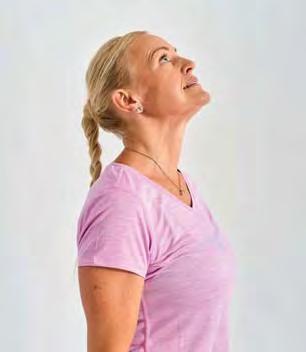



Stand with one foot in front of the other, and your arms crossed over your chest.

Maintain a balance position for 20 seconds with each foot in front.
Repeat twice.
Inthe next set, pass a small ball between your hands. In the final set, add head disturbances (alternate nods and tilts, twists, bends, and maintain position with your eyesclosed).








Stand with one foot in front of the other, and your arms crossed over your chest.

Maintain a balance position for 20 seconds with each foot in front.
Repeat twice.
Inthe next set, pass a small ball between your hands. In the final set, add head disturbances (alternate nods and tilts, twists, bends, and maintain position with your eyesclosed).








Stand barefoot with one foot in front of the other, and your arms crossed over your chest.

Maintain a balance position for 20 seconds with each foot in front. Repeat twice.
In the next set, pass a small ball between your hands. In the final set, include head disturbances (alternate nods and tilts, twists, and bends).








Stand barefoot with one foot in front of the other, and your arms crossed over your chest.

Maintain a balance position for 20 seconds with each foot in front.
Repeat twice.
In the next set, pass a small ball between your hands. In the final set, include head disturbances (alternate nods and tilts, twists, and bends).








Stand with one foot in front of the other, and your arms crossed over your chest.

Maintain a balance position for 20 seconds with each foot in front.
Repeat twice.
In the next set, pass a small ball between your hands. In the final set, include head disturbances (alternate nods and tilts, twists, and bends).








Stand with one foot in front of the other, and your arms crossed over your chest.

Maintain a balance position for 20 seconds with each foot in front.
Repeat twice.
In the next set, pass a small ball between your hands. In the final set, include head disturbances (alternate nods and tilts, twists, and bends).








Stand on one leg on a firm surface with your arms crossed over your chest.

Maintain this balance position for 20 seconds on each leg. Repeat twice.
In the next set, pass a small ball between your hands. In the final set, include head disturbances (alternate nods and tilts, twists, and bends).








Stand on one leg on a firm surface with your arms crossed over your chest.

Maintain this balance position for 20 seconds on each leg. Repeat twice. In the next set, pass a small ball between your hands. In the final set, include head disturbances (alternate nods and tilts, twists, and bends).








Stand barefoot on one leg on a firm surface with your arms crossed over your chest.

Maintain this balance position for 20 seconds on each leg. Repeat twice. In the next set, pass a small ball between your hands. In the final set, include head disturbances (alternate nods and tilts, twists, and bends).








Stand barefoot on one leg on a firm surface with your arms crossed over your chest.

Maintain this balance position for 20 seconds on each leg. Repeat twice. In the next set, pass a small ball between your hands. In the final set, include head disturbances (alternate nods and tilts, twists, and bends).








Stand on one leg on a narrow elevated surface with your arms crossed over your chest.

Maintain this balance position for 20 seconds on each leg. Repeat twice. In the next set, pass a small ball between your hands. In the final set, include head disturbances (alternate nods and tilts, twists, and bends).








Stand on one leg on a narrow elevated surface with your arms crossed over your chest.

Maintain this balance position for 20 seconds on each leg. Repeat twice. In the next set, pass a small ball between your hands. In the final set, include head disturbances (alternate nods and tilts, twists, and bends).



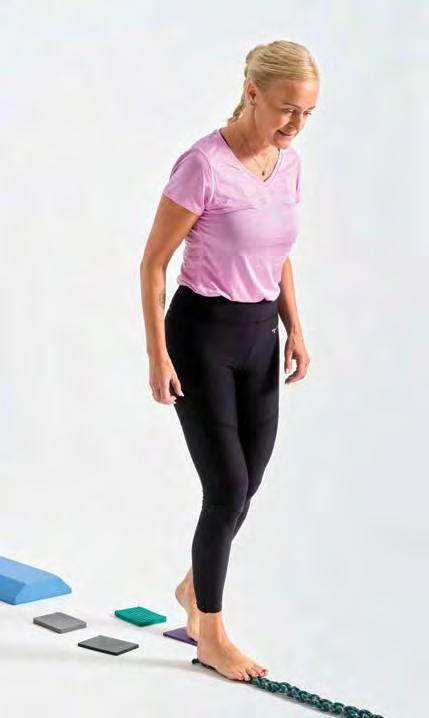







Walk along the course. Change the order of different surfaces (hard, soft, elevated, etc.) in each training session. Select two ways of walking the course, with one always being forward (regularwalking or tandem walking). You can also choose to walk backwards or sideways.

Repeat each movement twice. Then, in the third round, include head disturbances (alternate nods and tilts, twists, and bends).
Static Stretching Exercises for the Whole Body:
5 exercises, hold 30 seconds each exercise, repeat twice.


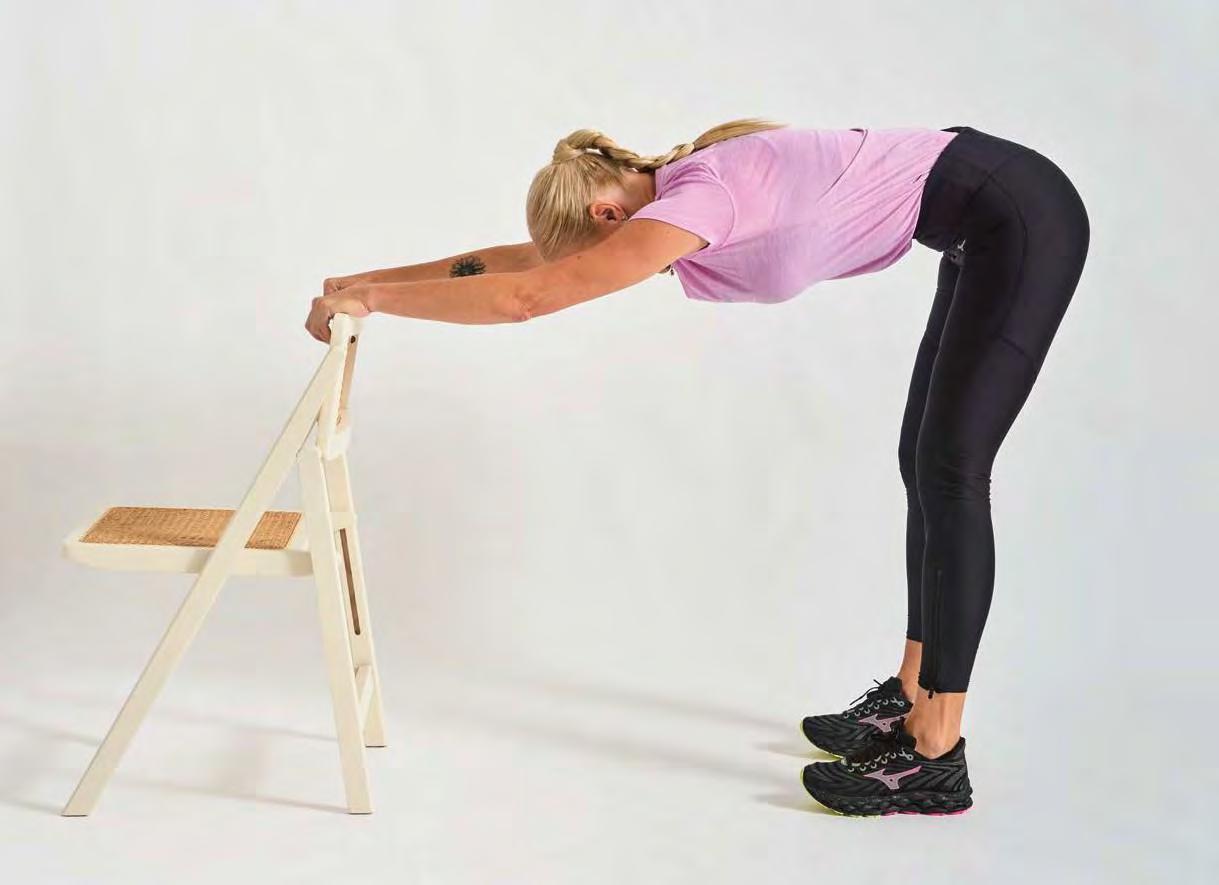
CONCLUDING PART OF THE EXERCISE – STRETCHING / Static Stretching Exercises for the Whole Body


Knee bend while supported against the wall.


Heal trust down while supported against thewall.
Regular physical activity helps maintain functional ability, bone density, and proper joint function, reducing the risk of injury from falls.
Overall, staying active is one of the most effective strategies for preventing falls and maintaining independence as we age.


























Part +BALANCE presents an exercise program to improve balance, which can be performed in pairs or in small groups.The basic instructions for performing the exercises in this section is:
Maintain balance position for 20 seconds on eachleg or with eachfoot in front. Repeat twice.
If the exercise contains different roles, change the role after two repetitions.
Balance 1:
Object HandlingBALL EXERCISES
Balance 2:
Dual TaskActivitiesCOUNTINGAND SPELLING
Balance 3:
Pair/Group Exercise-
BALL PASSING BY NAME OR NUMBER
Balance 4:
Balance ForwardPREDICTABLE DISTURBANCE
Balance 5:
Balance ForwardUNPREDICTABLE DISTURBANCE




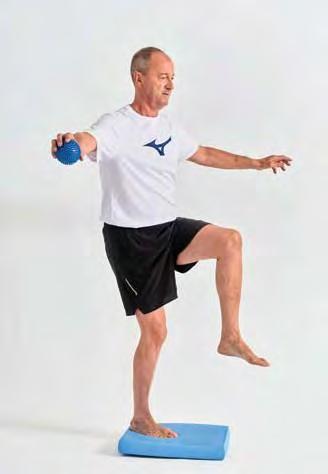






Maintain a balance position and hold the ball, while practising differentgrips.
Pass the ball in different directions (front, back, top, bottom). Try juggling the ball between hands while maintaingvarious balance positions.






Maintain various balance positions. Perform an activity while counting backwards, counting, spelling words aloud.







Pair/Group

Stand in a circle or pair up.
Pass the ball to someone when you call their name or number while maintaing various balancepositions.





Balance

Stand in a pairwhile holding elastic band.
Pull the elastic band in different sides to create predictable disturbance. Take turns and try to get your partneroff balance.






Stand in a pair on a soft or hard surface in different positions. Alternately pull an elastic band each to their own side, to create unpredictable balance challenges while maintaining balance position. Practice keeping balance after unexpected pulls also.
1.STATIC BALANCE PROGRESSION
Two-Leg Stance:
1. Stand on a firm surface with your eyes open.
2. Stand on a firm surface withyour eyes closed.
3. Stand on a soft surface with your eyes open.
4. Stand on a soft surface with your eyes closed.
Tandem Stance:
1. Stand heel-to-toe on a firm surface with your eyes open.
2. Stand heel-to-toe on a firm surface with your eyes closed.
3. Stand heel-to-toe on a soft surface with your eyes open.
4. Stand heel-to-toe on a soft surface with your eyes closed.
Single-Leg Stance:
1. Stand on one leg on a firm surface with your eyes open.
2. Stand on one leg on a firm surface withyour eyes closed.
3. Stand on one leg on a soft surface with your eyes open.
4. Stand on one leg on a soft surface with your eyes closed.
(Surface andVision)

• Change surface type (firm/soft) and vision (open/closed) as per above progression.
• Add variations with changing head positions to altervisual inputs.
External Disturbance:
• Apply gentle pushes from different directions while standing in a specific position (e.g.,singleleg stance) to challenge balance.
Internal Disturbance:
• Partner exercises, such as elastic band pulls, to introduce predictable balance challenges.

• Introduce a dual-task component while performing any of the static balance exercises.
• Examples:
- Count backward by threes.
- Spell simple words aloud.
- Recite months of the year in reverse.
5. UNPREDICTABLE DISTURBANCE
• Use a rope tied around yourwaist,with a partner giving sudden tugs to create unexpected balance challenges.
• Perform on both, hard and soft, surfaces.
Basic WalkingProgression:
1. Walk in a straight line on a firm surface.
2. Walk with your eyes closed.
3. Walk on a soft surface.
4. Walk heel-to-toe (tandem walking).
5. Add cognitive challenges (e.g.,counting backward while walking).
Variations with Disturbances:
• Use an elastic band attached to the waist while walking,with a partner adding resistance or sudden pulls.
• Walk while carrying an object to add complexity.
This progressive approach allows for gradual development of balance skills, from simple static positions to dynamic, complex tasks, addressing both physical and cognitive components of balance.
No matter the age, stay active


























Older adults often fall at home or in the vicinity of their home. Falls are caused by a combination of several factors related to the environment and the effects of physical ageing. Reduced muscle capacity and joint mobility, poorer balance and coordination, and reduced reaction time can increase the risk of falls.
Getting up from the ground after a fall requires a certain amount of mobility and strength.As with movement in general, there is no one and only rule for getting up from the floor, but you can help yourself using a pictorial description of the movements, to make getting up from the floor easier and to improve mobility in everyday life.
1. Sitting tostanding.
2. Transitionfrom standing to fourlegged position.
3. Transitionfrom fourlegged position to sidelying.
4. Transitionfrom side-lying to lying on a back.
5. Transitionfrom lying on a back to lying on your stomach.
6. Getting up from lying on your back via side support.
7. Getting up from lying on your stomach.
8. Safe lifting of loads – active position (slightly bent knees, co-contraction of core stabilizers).
9. Sitting-rising test.

1. Sit toward the front edge of a sturdy chair. Your knees should be bent and your feet should be flat on the floor, shloulder-width apart, and underneath your hips. Breathe continuously and slowly.

2. Activate your deep abdominal muscles by gently pullingyour navel toward your spine. Place your hands lightly on each side of the seat. Keep your back and neck as straight as possible, with your chest slightly forward.

3.
Lean forward and slightly shift your weight to the front of your feet.Trynot to support any weight with your hands.

4.
Stand and pause for a full breath in and out.

5.
Sit down slowly. Tighten your core and abdominal muscles to control your lowering as much as possible. You should lower yourself back to the chair slowly,not just drop back into the seat.


6. Breathe out slowlyas you sit on the chair. Do10-12 repetitions. Repeat 3times.
Additional instructions:
• Ifthe exercise is too difficult, use a chair with sturdy armrests, and push off the armrests to help you rise to the standing position. You can also use the armrests to help slowly lower yourself back to sitting.As this gets easier, try to use your arms less.You can also place a firm cushion or pillow on the chair to make the surface higher.
• Ifthis exercise is too easy,do not use your arms to help raise or lower yourself. You can also wear a weighted vest, use hand weights,increase your repetitions, or try a lower chair.

1. Activate your deep abdominal muscles by gently pullingyour navel toward your spine.

2. Place one foot forward and kneel. You can lean on your front leg with your hand.

3. Bring your legs together into a kneeling postion (in case of knee pain, perform the exercise on an exercise mat or cover your knees with a roll of towel).

4. If necessary, lean on a chair/wallwhile moving into a kneeling position.

5. Lean on your hands and lower yourself to fourlegged postion. Knees and. Knees are hip-width apart and belowthem, palms are shoulder-width apart and belowthem.


6. Stand up in the reverse order. Do 10-12 repetitions. Repeat 3 times on each side (kneel with your right then with your left leg).
Additional instructions:
• Ifthis exercise is too hard, you can lean on a chair, railing or wall when lowering down.
• Ifthis exercise is too easy, do not lean on your front leg when standing or lowering down.


In a fourlegged position on the floor, activate the deep abdominal muscles by gently drawing the belly button towards the spine.
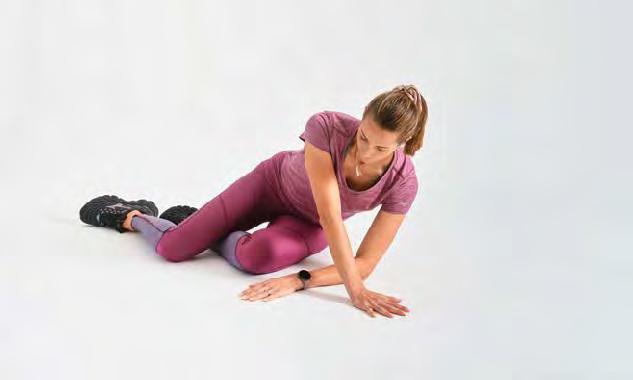
Lean on the elbowon the side you will lie down on and use the other hand to slowly lower yourself. 2.


3.
Maintain a side-sitting position. The legs are slightly bent.

Lower yourself into a side-sitting position. 5.
Slowly lower yourself into a side-lying position, lower arm outstretched.

6.
Return to the starting position in the reverse order. Do 10-12 repetitions. Repeat 3 times on each side.

1.
Lying on your side, activate your deep abdominal muscles by gently pulling your navel toward your spine.
Push off the ground with the hand on the side you will be facing.

2.
Extend your lower leg and bend your upper leg slightly.
Begin the transition with your lower body by pushing your knees from the floor towards the ceiling. Then move the upper part of your body by pushing yourself onto your back with both hands.


3.
Return to the starting position in the reverse order.
Do 10-12 repetitions.
Repeat 3 times on each side.




1.
Lying on your back, activate your deep abdominal muscles by gently pulling your belly button towards your spine.

4. Once on your side, extend your lower leg and slowly turn onto your stomach. Then fully extend your other leg aswell.
2. Fold your arms overyour chest. 5. Return to the starting position in the reverse order. Do 10-12 repetitions. Repeat 3 times on each side.
3.
Bend one leg. Start the transition to the side with the legs (push off the floor with the foot of the bent leg), followed by the upper body.

• Trythe movement with each leg separately to find your dominant side where turning will be easier for you.
• Practice turning on both sides.






1.
Lying on your side, activate your deep abdominalmuscles by gently pulling your navel toward your spine. 3.
Push off the ground with your upper arm, so you can place the elbow of your other arm into support.
Lean on the elbow of your lower arm. Raise yourself to a semi-sitting position with the help of your hands. 2.
By supporting yourself on your palms, lift your torso off the floor and stand on the floor (resting on your knees and palms).
5.
Hold the four-legged position. Knees are hip-width apart, palms shoulder-widthapart.






In an all-fours position move to the nearest chair or another stable objectnearby.
Additional instructions:
Straighten your spine and place one foot forward for support. Rest your hands on a nearby chair/furniture.
Stand up with support if needed.
Return to the starting position in the reverse order. Do 10-12 repetitions. Repeat 3 times on each side.
• Ifthe exercise is too hard, you can help yourself when standing up by leaning on a stable chair/furniture.
• Ifthe exercise is too easy,stand up without resting your hands on the support.
• Practise getting up from the floor in parts of the movement pattern, and as you get better at it, do the whole pattern at once.



Lying on your stomach, activate your deep abdominal muscles by gently pulling your belly button towards your spine. 2. Raise yourself up on your forearms and push your elbows back so they are under your shoulders. 3.
Leaning on your forearms, lift your torso off the floorand get into a low, fourlegged position (supporting yourself on your knees and forearms).


Raise yourself on your palms.Hold the fourlegged position. Knees are hipwidth apart and palms shoulder-width apart.





Straighten your spine and place one foot forward for support. 6. Lean on the leg with your hands in support and try to stand up slowlyin support and stand up. 7.
Return to the starting position in the reverse order.
Do 10-12 repetitions. Repeat 3 times on each side.
Additional instructions:
• Ifthe exercise is too hard, you can help yourself stand up by leaning on a stable chair that is securely placed against a wall. Ifthe exercise is still too hard, turn from the prone position to the side into the lateral position (see exercise 6 - Getting up via the side support from the supine position).
• Ifthe exercise is too easy,stand up without hands on the leg in support.


2.
Stand with your legs apart. Before lifting the load, activate the abdominal muscles deeply by gently pulling the belly button towards the spine. At the same time, activate the muscles of the pelvic floor (as if trying to hold back the leakage of urine and wind).


Bend your knees into a slight squat, keeping your spine straight. Keep the load close to your body. Use your leg muscles to lift the load. While lifting, maintain a straight spine and active deep abdominal and pelvic floor muscles. 3.
Lower the load slowlyto the ground, following the lifting rules.


Stand upright and ensure you have enough space around you (clear awayanypotential hazards!).
Carefully lower yourself into a crosslegged sitting position. Trynot to use your arms or hands as leverage or support.
Once stably seated, attempt to stand back up, trying not to use your hands or knees for support.
You can achieve a total of 10 points: each additional support used (e.g. hand or knee) means a deduction of one point, and half a point for any loss of balance during the movement (see scorecard on the following page).


Hand support: -1point


Support on the forearm: -1point Knee support: -1point
GOOD: 8-10points
FAIR: 3,5-7,5points


Support with palm on knee: -1point Side support: -1point
POOR: 0-3 points
The maximum possible score on the test is 10 points: a possible total of 5 points for sitting down, and 5 points for rising from the floor to a standing position.
Using your hand, forearm, knee, or the side of your leg to press up from the ground or bracing your hand on your knee results in a deduction of one point.
An additional 0.5 points is deducted if the evaluator perceives an unsteady execution or partial loss of balance in any of the movement.
Prof. Dr. Maja Dolenc is a full professor at the Faculty of Sport, where she teaches in the field of sports recreation and fitness. She is the author of ten university textbooks and more than 130 scientific and 160 professional articles. Her research focuses on physical activity as a key component of a healthy lifestyle, particularly in the context of aging, fall prevention, and health promotion. Prof. Dolenc has supervised over 125 bachelor’s and master’s thesesand hasconducted morethan 50 training courses,attended by 3,700 participants. In addition to her teaching and research work, she is actively engaged in various professional bodies and committees at the Faculty of Sport, the Olympic Committee of Slovenia, and the Slovenian Sports Union. She has participated in numerous national and international projects aimed at promoting physical activity, health, and active lifestyles. Her achievements have significantly contributed to the development of sports recreation in Slovenia and beyond.


Tjaša Knific has a Master’s degree in physiotherapy and is a former elite athlete. She is employed as a developmental associate at the National Institute of Public Health (NIJZ) in the Centre for Preventive and Health Promotion Programs, where she leads the expert group on physical activity, sedentary behavior, and sleep. Her work includes research, management, and implementation of strategies in clinical practice, as well as lecturing in the fields of public health, physiotherapy, health promotion and prevention, daily physical behavior in adults, and active and healthy ageing. She actively participates in the training of healthcare professionals, the development and implementation of health programs, and the preparation of public health policies. Additionally, she is a lecturer at several Slovenian health faculties and the author or co-author of numerous articles, master’s and bachelor’s theses, manuals, and teaching materials on physical activity for health, physical fitness, and reducing sedentary behavior.
ABC+ movement program for active ageing and vital living
Authors: Maja Dolenc* and Tjaša Knific**
Publisher: National Institute of Public Health of the Republic of Slovenia, Trubarjeva 2, Ljubljana
Lector: MihaelaTornar
Photography: Marja Bizjak Ažman and Domen Bizjak
Design:HercogMartini
Ljubljana, 2025
Electornic edition
Published on:https://nijz.si
*Faculty of Sport, University of Ljubljana, Slovenia
**National Institute of Public Health, Ljubljana, Slovenia



All rights reserved. Reproduction in part orin full on any manner orin anymedium is not permitted without written permission of the authors.Violations shall be sanctioned in accordance with copyright and criminal law.






Cataloguing in publication (CIP) prepared by National and University Library in Ljubljana COBISS.SI-ID 221095939
ISBN 978-961-7211-55-9(PDF)

Funded by the European Union. Views and opinions expressed are however those of the author(s) only and do not necessarily reflect those of the European Union or the European Education and Culture Executive Agency (EACEA). Neither the European Union nor EACEA can be held responsible for them.